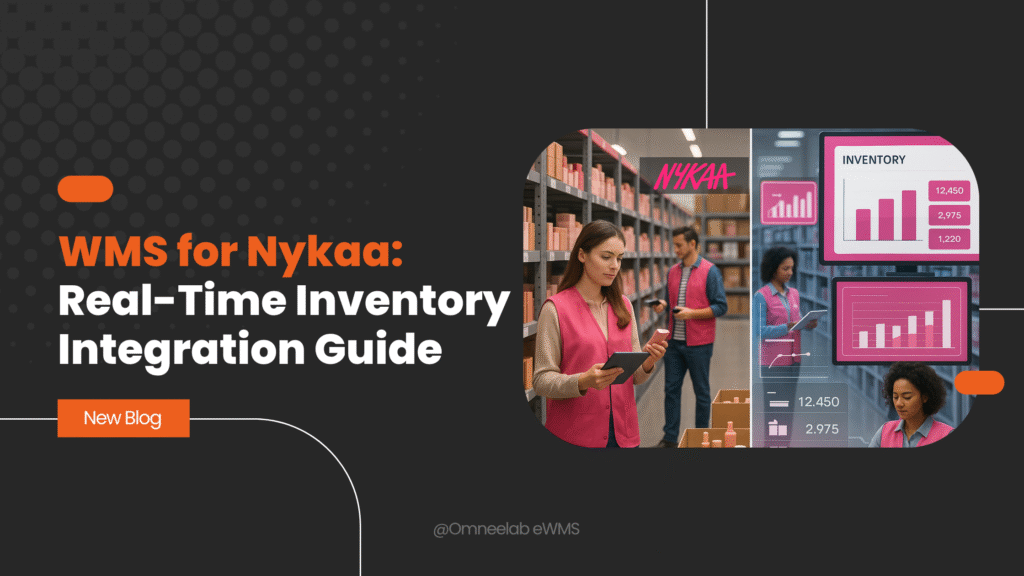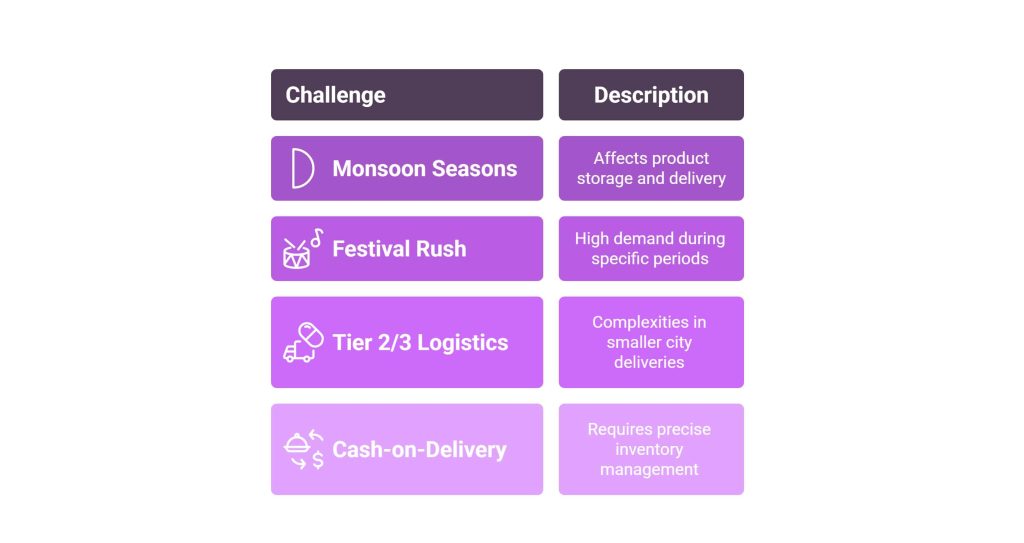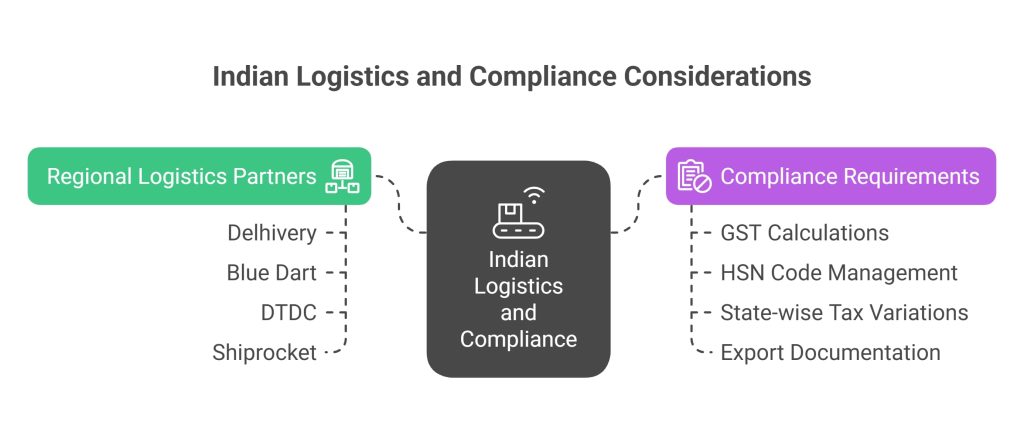Picture this: You’re a beauty brand seller on Nykaa, and it’s the day before Diwali. Orders are flooding in faster than you can count, but suddenly you realize you’ve oversold your bestselling lipstick shade by 50 units. Your customers are frustrated, your ratings are dropping, and you’re scrambling to figure out what went wrong.

This nightmare scenario happens to countless sellers who rely on manual inventory tracking or outdated systems. However, savvy Nykaa sellers are turning to Warehouse Management Systems (WMS) with real-time inventory integration to avoid such disasters and streamline their operations.
In this comprehensive guide, we’ll explore how WMS for Nykaa can transform your selling experience through seamless integration, helping you maintain accurate stock levels, improve customer satisfaction, and scale your business efficiently. Whether you’re a small beauty brand or an established seller, understanding Nykaa warehouse management system integration is crucial for staying competitive in India’s booming e-commerce market.
Understanding WMS and Its Importance for Nykaa Sellers
What is a Warehouse Management System?
A Warehouse Management System (WMS) is sophisticated software that helps businesses manage their warehouse operations, from receiving inventory to shipping orders. Think of it as the brain of your warehouse operations, coordinating everything from stock placement to order fulfillment.
For Nykaa sellers, a WMS becomes even more critical because beauty products often have:
- Expiration dates that need careful tracking
- Multiple variants (shades, sizes, formulations)
- Seasonal demand fluctuations
- High return rates due to color mismatches
The Indian E-commerce Landscape Challenge
According to the Indian Brand Equity Foundation, India’s e-commerce market is expected to reach $200 billion by 2026. However, this growth brings unique challenges for beauty sellers:
- Monsoon seasons affecting product storage and delivery
- Festival rush periods like Diwali, Dussehra, and regional celebrations
- Tier 2 and Tier 3 city logistics complexities
- Cash-on-delivery preferences requiring precise inventory management

Why Traditional Inventory Methods Fall Short
Many sellers still rely on spreadsheets or basic inventory software, but these methods create several problems:
- Manual errors leading to overselling or stockouts
- Delayed updates causing inventory discrepancies
- Limited visibility across multiple sales channels
- Time-consuming reconciliation processes
Real-time inventory for Nykaa sellers addresses these challenges by providing instant, accurate stock information across all platforms.
The Power of Real-Time Inventory Integration
What Does Real-Time Integration Mean?
Real-time inventory syncing means your stock levels update instantly across all platforms whenever a sale occurs, inventory arrives, or returns are processed. When a customer purchases your foundation on Nykaa, your WMS immediately reflects this change across your entire system.
Key Benefits for Nykaa Sellers
- Elimination of Overselling With Nykaa seller integration, you’ll never accidentally sell products you don’t have. The system automatically prevents orders when stock reaches zero.
- Improved Customer Experience Accurate inventory means customers receive their orders on time, leading to better reviews and higher seller ratings on the platform.
- Better Cash Flow Management Real-time data helps you understand which products are moving fast and which are sitting idle, enabling smarter purchasing decisions.
- Reduced Manual Work Warehouse automation for Nykaa marketplace eliminates the need for constant manual inventory updates, freeing up time for strategic activities.
Real Success Story: Mumbai Beauty Brand
Leading Mumbai-based organic skincare brand, shares her experience: “Before implementing WMS integration, we were losing ₹2-3 lakhs monthly due to overselling during festival seasons. Our team spent 15 hours weekly just updating inventory across platforms. After integrating with Omneelab’s AI-powered WMS solution, we eliminated overselling completely and reduced manual work by 80%. During last year’s Diwali sale, we processed 500% more orders without a single inventory error.”
How Nykaa Seller Integration Works
The Technical Process
Nykaa seller dashboard integration typically involves several steps:
- API Connection: Your WMS connects to Nykaa’s seller portal through secure APIs
- Data Synchronization: Product information, pricing, and inventory levels sync automatically
- Order Processing: When orders come in, they’re automatically sent to your WMS for fulfillment
- Status Updates: Shipping and tracking information flows back to Nykaa’s platform
Integration Architecture
The Nykaa warehouse management system integration follows a hub-and-spoke model:
- Central Hub: Your WMS serves as the central inventory source
- Spokes: Various sales channels (Nykaa, your website, other marketplaces) connect to this hub
- Real-time Sync: All channels receive instant updates when inventory changes

Essential Features of WMS for Nykaa Sellers
Core Inventory Management Capabilities
Multi-channel inventory management Nykaa requires specific features:
- Batch and Expiry Tracking: Beauty products have shelf lives, and your warehouse software for Nykaa sellers must track expiration dates to ensure FIFO (First In, First Out) rotation. This is particularly crucial for Indian sellers dealing with monsoon humidity and temperature variations.
- Variant Management: Managing multiple SKUs for products with different shades, sizes, or formulations becomes effortless with proper WMS integration.
- Real-time Stock Alerts: Set automatic notifications when inventory levels drop below predetermined thresholds, preventing stockouts.
Advanced Analytics and Reporting
Inventory management for Nykaa becomes more strategic with built-in analytics:
- Sales velocity reports showing which products move fastest
- Seasonal trend analysis helping predict demand patterns
- Profit margin calculations by product and category
- Reorder recommendations based on historical data and current trends
Order Management Integration
Nykaa seller order tracking becomes seamless when your WMS integrates with order management features:
- Automatic order routing to the nearest warehouse
- Pick list generation and optimization
- Shipping label creation and courier integration
- Return processing and restocking
Choosing the Right WMS for Your Nykaa Business
Factors to Consider
Scalability Your chosen third-party WMS for Nykaa sellers should grow with your business. Consider systems that can handle increased order volumes and additional sales channels.
Integration Capabilities Look for WMS solutions that offer robust e-commerce WMS integration India features, including:
- Pre-built Nykaa connectors
- API flexibility for custom integrations
- Support for multiple marketplaces
- Accounting software integration
User-Friendly Interface Your team needs to use the system daily, so prioritize solutions with intuitive interfaces and comprehensive training resources.
Popular WMS Options for Indian Sellers
Cloud-Based Solutions
- Omneelab eWMS: AI-powered solution specifically designed for Indian e-commerce sellers with comprehensive Nykaa integration
- Unicommerce: Popular among Indian e-commerce sellers
- Zoho Inventory: Affordable for small businesses
- TradeGecko (QuickBooks Commerce): Good for growing businesses
On-Premise Systems
- Manhattan Associates: Enterprise-level solution
- Oracle WMS: Comprehensive but complex
Hybrid Approaches Combining cloud convenience with on-premise security, these solutions work well for established sellers with specific compliance requirements.
Case Study: Delhi Cosmetics Distributor
A Delhi based distributer transformed his business with omnichannel inventory software India: “We were selling on Nykaa, Amazon, and our own website, but managing inventory was a nightmare. During the 2023 festive season, we had ₹8 lakh worth of dead stock due to poor visibility. After implementing Omneelab’s comprehensive WMS suite with Nykaa integration, we achieved 99.5% inventory accuracy and expanded to Myntra and Flipkart within six months. Our revenue grew 150% while reducing operational costs by 30%.”
Implementation Best Practices
Pre-Implementation Planning
Data Cleanup Before implementing Nykaa seller panel inventory sync, clean up your existing product data:
- Standardize product names and descriptions
- Verify SKU accuracy
- Update pricing information
- Audit current inventory levels
Team Training Invest in comprehensive training for your team on the new warehouse automation for Nykaa marketplace system.
Step-by-Step Integration Process
Phase 1: System Setup (Week 1-2)
- Configure your WMS with product catalogs
- Set up user permissions and workflows
- Establish inventory locations and zones
Phase 2: Nykaa Connection (Week 2-3)
- Connect to Nykaa’s seller APIs
- Map product fields between systems
- Configure sync frequencies and rules
Phase 3: Testing (Week 3-4)
- Run parallel operations to verify accuracy
- Test various scenarios (sales, returns, adjustments)
- Train staff on new processes
Phase 4: Go-Live (Week 4-5)
- Switch to live integration
- Monitor closely for the first few weeks
- Address any issues promptly
Local Implementation Considerations
Regional Logistics Partners Integrate with popular Indian logistics providers:
- Delhivery: Strong pan-India network
- Blue Dart: Premium delivery services
- DTDC: Cost-effective for tier 2/3 cities
- Shiprocket: Aggregator with multiple courier options

Compliance Requirements Ensure your WMS handles Indian regulatory requirements:
- GST calculations and reporting
- HSN code management for beauty products
- State-wise tax variations
- Export documentation for international sales
Overcoming Common Integration Challenges
Technical Hurdles
API Limitations Some sellers face restrictions with Nykaa’s API capabilities. Work with your WMS provider to understand these limitations and develop workarounds.
Data Mapping Issues Product attributes might not align perfectly between your WMS and Nykaa’s requirements. Create comprehensive mapping documents to address these discrepancies.
Operational Challenges
Staff Resistance Change can be difficult. Address concerns through training, highlighting benefits, and involving key team members in the selection process.
Initial Setup Complexity Stock level updates Nykaa integration can seem overwhelming initially. Break the process into manageable phases and celebrate small wins.
Troubleshooting Common Problems
Problem 1: Inventory Sync Delays
- Cause: Network connectivity issues or API rate limits
- Solution: Implement retry mechanisms and optimize sync frequency
- Prevention: Choose WMS with robust error handling
Problem 2: SKU Mapping Errors
- Cause: Inconsistent product naming conventions
- Solution: Create comprehensive SKU mapping spreadsheet
- Prevention: Standardize naming conventions before integration
Problem 3: Order Processing Delays
- Cause: Manual approval processes or insufficient automation
- Solution: Configure automatic order acceptance rules
- Prevention: Set up proper workflow automation from day one
Problem 4: Return Processing Issues
- Cause: Lack of reverse logistics integration
- Solution: Implement return management module
- Prevention: Plan return workflows during initial setup
Measuring Success: KPIs for WMS Integration
Inventory Accuracy Metrics
Stock Accuracy Rate Measure the percentage of time your system inventory matches physical inventory. Aim for 99%+ accuracy.
Stockout Frequency Track how often products go out of stock unexpectedly. This should decrease significantly with proper real-time inventory syncing.
Operational Efficiency Indicators
Order Processing Time Measure the time from order receipt to shipment. Seller fulfillment automation Nykaa should reduce this significantly.
Error Rates Track picking errors, shipping mistakes, and other operational issues that affect customer satisfaction.

Financial Performance
Inventory Turnover Monitor how quickly you’re selling through inventory. Better data should lead to improved turnover rates.
Carrying Cost Reduction Calculate the decrease in storage costs due to better inventory optimization.
KPI Dashboard Example

Future Trends in WMS Integration
Artificial Intelligence and Machine Learning
The next generation of Nykaa WMS features will likely include:
- Predictive analytics for demand forecasting
- Automated reordering based on AI recommendations
- Dynamic pricing optimization
- Customer behavior analysis for inventory planning
Omneelab’s AI-powered warehouse management solutions are already leading this transformation, offering advanced machine learning capabilities that help sellers predict demand patterns and optimize inventory levels automatically.
Enhanced Mobile Capabilities
Omni-channel inventory integration will become more mobile-centric, allowing sellers to manage operations from anywhere. Indian sellers, especially those managing multiple locations, will benefit from mobile-first WMS solutions.
Sustainability Features
Environmental consciousness is growing, and future WMS solutions will include features for:
- Expiry date optimization to reduce waste
- Sustainable packaging recommendations
- Carbon footprint tracking for shipments
Voice and IoT Integration
Emerging technologies will transform warehouse operations:
- Voice-guided picking reducing errors
- IoT sensors for automatic inventory counting
- Smart shelving with weight sensors
- Drone inventory for large warehouses
Cost-Benefit Analysis
Investment Considerations
Initial Costs
- Software licensing or subscription fees: ₹5,000-50,000/month
- Implementation and setup costs: ₹50,000-2,00,000
- Training expenses: ₹20,000-50,000
- Potential hardware requirements: ₹1,00,000-5,00,000
Ongoing Expenses
- Monthly/annual subscription fees
- Maintenance and support costs
- Additional user licenses as you grow
- Integration updates and customizations
Return on Investment
Direct Savings
- Reduced labor costs through automation: 30-50% reduction
- Lower inventory holding costs: 15-25% reduction
- Decreased error-related expenses: 40-60% reduction
- Improved cash flow from better inventory turnover: 20-30% improvement
Indirect Benefits
- Better customer satisfaction leading to repeat business
- Improved seller ratings on Nykaa
- Scalability enabling business growth
- Competitive advantage in the marketplace
ROI Calculation Example
Small Beauty Brand (₹50 lakh annual revenue)
- WMS Investment: ₹3 lakh annually
- Labor savings: ₹6 lakh annually
- Reduced stockouts: ₹4 lakh additional revenue
- Error reduction: ₹2 lakh savings
- Net ROI: 300% in first year
Regional Considerations for Indian Sellers
North India Challenges
Delhi NCR Region
- High competition requiring efficient operations
- Extreme temperature variations affecting product storage
- Complex logistics due to traffic congestion
Punjab & Haryana
- Agricultural economy seasonal patterns
- Growing beauty consciousness in tier 2 cities
- Need for vernacular language support
South India Opportunities
Bangalore & Hyderabad
- Tech-savvy customer base
- Strong logistics infrastructure
- Growing startup ecosystem
Chennai & Kochi
- Traditional beauty practices meeting modern trends
- Port connectivity for international brands
- Monsoon-specific storage requirements
West India Dynamics
Mumbai & Pune
- Fashion and beauty hub of India
- High real estate costs requiring efficient space utilization
- Fast-paced lifestyle demanding quick delivery
Gujarat
- Strong business community
- Growing disposable income
- Entrepreneurial mindset
East India Potential
Kolkata & Bhubaneswar
- Cultural appreciation for beauty products
- Growing e-commerce adoption
- Need for localized inventory strategies
Regulatory and Compliance Considerations
Indian E-commerce Regulations
Foreign Direct Investment (FDI) Rules
- Marketplace model compliance
- Inventory ownership restrictions
- Pricing and discount regulations
Goods and Services Tax (GST)
- Proper HSN code classification for beauty products
- Interstate supply chain tax implications
- Digital invoice requirements
Bureau of Indian Standards (BIS)
- Quality certification for cosmetic products
- Labeling requirements in local languages
- Safety and testing compliance
Data Protection and Privacy
Personal Data Protection Bill
- Customer data handling requirements
- Cross-border data transfer restrictions
- Consent management protocols
Building Your WMS Integration Roadmap
3-Month Implementation Timeline
Month 1: Foundation
- Week 1-2: Vendor selection and contract finalization
- Week 3-4: Data cleanup and system preparation
Month 2: Integration
- Week 5-6: WMS setup and configuration
- Week 7-8: Nykaa API integration and testing
Month 3: Optimization
- Week 9-10: Go-live and monitoring
- Week 11-12: Performance optimization and team training
Long-term Scaling Strategy
Year 1: Consolidation
- Perfect single-channel (Nykaa) operations
- Achieve 99%+ inventory accuracy
- Establish efficient workflows
Year 2: Expansion
- Add 2-3 additional marketplaces
- Implement advanced analytics
- Explore automation opportunities
Year 3: Innovation
- AI-powered demand forecasting
- Voice-enabled warehouse operations
- International expansion preparation
Conclusion
Implementing a WMS for Nykaa with real-time inventory integration isn’t just about technology—it’s about transforming your entire business operation. The beauty industry moves fast, trends change quickly, and customer expectations continue to rise. Sellers who embrace warehouse automation for Nykaa marketplace position themselves for sustainable growth and success.
The journey from manual inventory tracking to automated, real-time systems might seem daunting, but the benefits far outweigh the challenges. With proper planning, the right WMS solution, and commitment to change, you can eliminate inventory headaches, improve customer satisfaction, and focus on what you do best—growing your beauty business.
Remember, real-time inventory for Nykaa sellers isn’t a luxury anymore—it’s a necessity for staying competitive. The question isn’t whether you should integrate a WMS, but how quickly you can implement one to start reaping the benefits.
As India’s e-commerce market continues its explosive growth, sellers who invest in robust inventory management for Nykaa today will be the market leaders of tomorrow. The success stories we’ve shared demonstrate that regardless of your business size, WMS integration can deliver transformational results.
Ready to transform your Nykaa selling experience? Start by exploring Omneelab’s comprehensive WMS integration solutions specifically designed for Indian e-commerce sellers. Download our comprehensive WMS integration checklist for Nykaa sellers, evaluate your current inventory challenges, and take the first step toward automated, accurate, and efficient inventory management.
Don’t let inventory management hold back your beauty business growth. The future of e-commerce belongs to sellers who embrace technology, optimize operations, and deliver exceptional customer experiences. Make your move today.
Frequently Asked Questions
Nykaa sellers integrate through API connections linking their seller dashboard with the WMS. The process involves product data mapping, automatic sync setup, and inventory rule configuration. Most WMS providers offer pre-built Nykaa connectors for seamless real-time inventory updates across all sales channels.
Key benefits include elimination of overselling, improved customer satisfaction, better cash flow management, and reduced manual work. Sellers experience fewer stockouts, accurate order fulfillment, and enhanced inventory visibility, leading to higher ratings and business growth on the platform.
The best WMS depends on business size and budget. Cloud solutions like Omneelab eWMS, Zoho Inventory, and Unicommerce work well for small-medium sellers. Enterprise operations prefer Manhattan Associates or Oracle WMS. Consider Nykaa integration capabilities, scalability, and beauty-specific features like expiry tracking.
WMS eliminates human error through automated processes including optimized pick lists, barcode scanning, and efficient picking routes. Real-time inventory tracking prevents overselling while automated quality checks ensure correct product shipment, significantly reducing errors and customer complaints.
Yes, it’s essential for competitive success. The beauty industry’s fast trends, seasonal variations, and high customer expectations make accurate inventory crucial. Real-time tracking prevents overselling, maintains customer satisfaction, and provides competitive advantage, especially during festival seasons and sales events.
People also read:
- WMS for Snapdeal
- JioMart WMS Integration
- Inventory Management with Barcode Technology
- Common Inventory Management Challenges
- WMS for Magento
- WMS for WooCommerce
- WMS for Last Mile in India
- Small Business Barcoding
- Guide to Managing Perishable Inventory
- What Is a Bill of Materials (BOM)? Expert Guide & Tips

Kapil Pathak is a Senior Digital Marketing Executive with over four years of experience specializing in the logistics and supply chain industry. His expertise spans digital strategy, search engine optimization (SEO), search engine marketing (SEM), and multi-channel campaign management. He has a proven track record of developing initiatives that increase brand visibility, generate qualified leads, and drive growth for D2C & B2B technology companies.